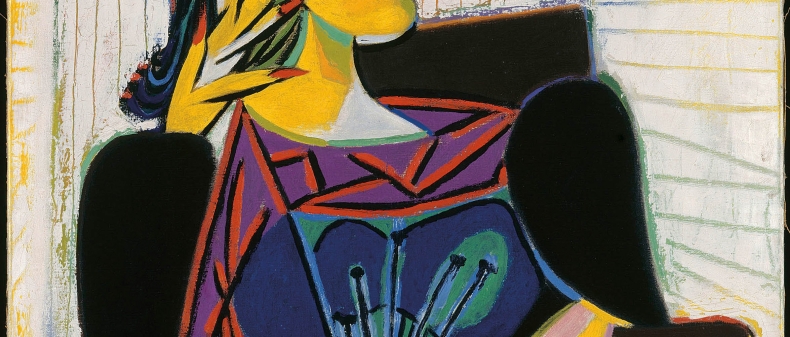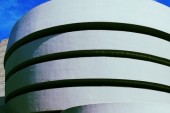
Pablo Picasso’s Portrait of Dora Maar (1937), © Picasso Estate / SODRAC (2011)
The way through the first half of 20th century art runs invariably by Picasso. In historical canon-speak, the Father of Cubism brings to a head the fulminating experimentation of the European avant-garde, announces the beginnings of High Modernism, and therefore presages the course of abstraction, not just in painting, but also in sculpture. Megalomaniacal, relentlessly ambitious, driven, prolific, he is a polestar of the 20th century artistic persona (the other, I would argue, is Warhol).
Seeing him (at least, seeing him properly) is now simply impossible. Between secondary market prices inflating insurance costs and the age and fragility of the paintings themselves, any work considered signature or exemplary in any way isn’t moving. Guernica isn’t leaving Madrid; nor is Les Demoiselles D’Avignon leaving MoMA. The rest of his commonly known work is likewise firmly entrenched in either New York or Europe, and there are precious few museums with the resources to import them. So what are we left with?
We are left with shows like the AGO’s spring blockbuster, Picasso: Masterpieces from the Musée National, Paris. The opening didactic panel (shockingly, the only one in the show, as of preview time) goes on for two paragraphs in breathless and general terms about what everybody already knows: ambitious, prodigy, genius, innovator, yadda yadda yadda. Not one word of context, either of the provenance or the organization of this show, both of which are essential factors in its viewing and potential reception.
It was imported (as per the exhibition title) from Paris, and culls together works from its Musée National that were Picasso’s. That is to say, works beyond public circulation, which he kept for himself, or remained in his studio. There are three reasons (well, two and a half, really) why Picasso would maintain ownership of such pieces: sentimental value; they were never sold; or he never wanted them to be a part of his public legacy. This was the most graspingly ambitious artist of the last century, a man whose reputation was self-made, and (perhaps more importantly) self-willed: that works might have sentimental value is self-explanatory, but consider the implications of someone like Picasso not selling something or consciously prohibiting it from circulation. This copiously prolific man, who propelled himself to the epicentre of 20th century art, wanted to absent these works from the public record.
All this is to say that most of the work in the show is, to use a polite phrase, decidedly minor. It is a highly idiosyncratic way of seeing Picasso, certainly not a good way to introduce anyone to him, or to introduce anyone to seeing him live, and for whatever reason the curators of the show (who go uncredited here — perhaps it was arranged and administrated, not curated) treat the material as if it were beyond critical organization.
The work is laid out purely chronologically, which leads to some odd moments, especially at the beginning. In sketches and studies, we see him work through his various phases: absorbing, processing, digesting European art, trying on Fauvism and post-Impressionism, wrestling with Degas, Cezanne and Monet, experimenting with form and structure and pictorial space; in short, building steam and speed towards the epoch-defining seismic shifts of Guernica and Demoiselles D’Avignon. The great climaxes in this chronological narrative are absent.
And the work that is in the show? Sketches, studies, early attempts, rehearsals, a few portraits, some (likely) treasured keepsakes of lovers like Fernande Olivier, Olga Khokhlova and Dora Maar; of the pieces dated after the Second World War, doodles and endless reiterations of what had become his signature style.
There are things to glean from this show. Regardless of what one thinks of individual works, his unerring confidence belts out from each piece: that kind of restless assurance (and by implication, utter willingness to fail) is rare to see anywhere. After a career’s worth of tireless experimentation and deconstruction, Picasso knew space and form from the inside out; it’s nice to see the process and progress of struggle represented by some of the early paintings.
There are beautiful moments, as in the portrait of Dora Maar that is wisely the show’s public face: the way her face, in and amongst the crude outlines and fried-egg eyes, is given form and mass by exquisitely subtle shades of orange, yellow, pink and green; the balancing act of staccato slashes and graceful, tremulous fogs of colour.
I’m always struck by Picasso’s tastelessness and libidinous vulgarity, his puckishly nasty sense of humor. His abstracted nudes are gleefully vicious parodies of academic odalisques, where the exploded space of cubism is repurposed to pornographic ends: rotund blobs of garish pink and lavender, the body distorted and distended so that tits, bum and a crude dash for a vagina are always simultaneously on display.
So, in the end, what is there to be said? No one argues about Picasso anymore: he is the canon, get used to it. So what that these paintings were never meant to be part of his public record? The show will be packed (the AGO has already instituted timed-entry ticket selling), and everyone will be peering over rows of heads trying to catch a glimpse of genius. If you ask me, the show is markedly short on genius; even so, I can think of worse ways to spend $25.
______
Sholem Krishtalka is the Toronto Standard’s art critic.
For more, follow us on Twitter at @torontostandard, and subscribe to our newsletter.












